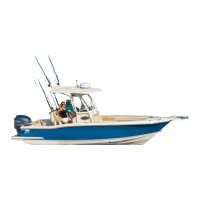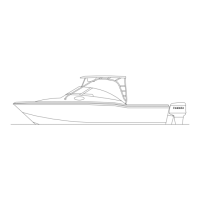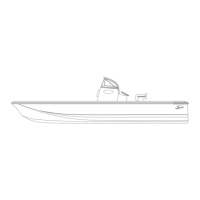Do you have a question about the Scout Boats 245 Abaco and is the answer not in the manual?
Owner's manual for the Scout 245 Abaco boat, providing operational and maintenance information.
Defines DANGER, WARNING, and CAUTION statements used in the manual for safety.
Fields to record boat, engine, trailer, and dealer information for service and assistance.
Technical specifications for the Scout 245 Abaco, including dimensions, capacities, and performance.
Details on manufacturer, hull identification, engine serial numbers, and design category.
Information on weight limits, maximum load capacity, persons, and rated engine horsepower.
Details federal requirements for boat registration, insurance responsibilities, and number display.
Procedures for reporting accidents and recommendations for boating safety education courses.
Details USCG regulations for required safety equipment and compliance standards.
Guidance on warranty registration, product changes, service procedures, and warranty transfer.
Information on Yamaha engine warranty, registration, and contact for service and coverage.
Details the transferable structural hull warranty for ten years and stem-to-stern for three years.
Procedures for warranty service, including dealer registration and limitations of the warranty.
Instructions for transferring the warranty and registering the boat online via dealerscircle.com.
Overview of outboard engines, their maintenance, and the importance of warranty registration.
Explains drive system corrosion, marine growth, and preventative measures.
Details engine lubrication for 2-cycle and 4-cycle motors, including oil types and monitoring.
Describes the engine cooling system, water pump, and how to check for proper operation.
Information on propeller types, sizing, identification, and the importance of immediate repair for damage.
Explains engine instruments and alarms, including tachometer, speedometer, fuel, and voltmeters.
Details the function of the engine tilt/trim gauge, tilt/trim switches, and engine alarm systems.
Overview of helm control systems including throttle, steering, and trim tabs, emphasizing manual review.
Explains engine throttle and shift controls, covering cable and electronic systems for single/dual engines.
Details single lever binnacle and electronic control systems, including keypad features and operation.
Explains the neutral safety switch's role in preventing starting in gear and its testing procedure.
Details the operation of engine power tilt and trim, including switch locations and angle adjustments.
Guidance on outboard trim operation, tilt angles, and the importance of stern seat backrest position.
Describes the hydraulic steering system, including components, single/dual engine configurations.
Explains the operation and function of trim tabs for hull attitude control and LED trim indicators.
Guidance on trim tab operation and maintenance of control systems, including lubrication and adjustments.
Details trim tab maintenance, including actuator care, marine growth prevention, and zinc anode use.
Overview of the fuel system design, inspection requirements, and critical safety warnings.
Information on fuel tank withdrawal tubes, fuel fill location, operation, and proper fuel cap usage.
Details the outboard fuel system, including tank configuration, filters, and anti-siphon valve function.
Provides step-by-step instructions for safe fueling, emphasizing static electricity prevention and spill response.
Covers fuel system maintenance, including inspection of components, O-rings, vent screens, and fuel aging.
Overview of the 12-volt DC electrical system, battery types, charging, and wiring identification.
Details the 12-volt system, including battery location, selector switches, and circuit breaker panels.
Explains the function of battery switches, VSR, and the helm accessory switch panel.
Describes the functions of various accessories controlled by the main accessory switch panel.
Details the operation of forward and aft bilge pumps, including manual and automatic switch functions.
Explains the operation of the baitwell pump, raw water washdown pump, and windlass.
Covers horn, electrical receptacles, MP3 connection, and additional DC switch panels like trim tab and engine controls.
Details main circuit breakers and standard push-to-reset breakers protecting various boat systems.
Describes the optional AC battery charger, its connection to shore power, and important safety precautions.
Guidance on maintaining the 12-volt DC system, including electrical component protection and wiring checks.
Covers battery maintenance for sealed and wet cell types, and AC electrical system inspection.
Overview of the fresh water system, including tank, distribution lines, pump, and safety warnings.
Instructions for filling the fresh water tank, priming the pump, and system operation.
Details routine maintenance for the fresh water system, including strainer cleaning and pump switch operation.
Provides guidance on system care, battery maintenance, water conditioning, and sanitizing the fresh water tank.
Overview of raw water systems, including pump location, seacocks, and system priming procedures.
Explains the operation of the raw water washdown system, including pump activation and hose connection.
Details the washdown hose connection and the operation of the baitwell pump for recirculation and aeration.
Covers routine maintenance for the raw water system, including checking hoses, cleaning strainers, and operating seacocks.
Overview of drainage systems, including gravity and pumped drainage methods and thru-hull fittings.
Details cockpit drains, scuppers, check valves, and the gutter system for water channeling.
Explains bilge drainage, including manual and automatic bilge pumps, switches, and high water alarms.
Guidance on operating bilge pumps and the importance of checking the garboard drain plug.
Essential maintenance for drainage systems, including cleaning drains, strainers, and operating thru-hull valves.
Details cabin ventilation provided by the deck hatch and opening port windows.
Explains carbon monoxide hazards, proper ventilation techniques, and symptoms of exposure.
Covers maintenance of the ventilation system, including testing the CO alarm and caring for acrylic components.
Describes deck and rail systems, including handrails, retractable cleats, and optional bow cleat/lifting ring.
Information on the anchor locker, including proper anchor storage and securing methods.
Details the optional bow pulpit, roller, and windlass systems, including their operation and safety.
Covers windshield care and maintenance, and the integrated engine mounting system.
Describes the swim platform, telescopic ladder, and transom-mounted handrail.
Details general cockpit features like latches and doors, and the folding stern bench seat.
Details general cockpit features like latches and doors, and the folding stern bench seat.
Information on the optional ski tow pylon and the location of trim tabs.
Describes access to the stern bilge and the location of cockpit rod storage racks.
Details helm seat adjustment, bolster function, storage compartments, and the slide-out cooler.
Describes helm station features like table and storage, and the cabin door and hatch security.
Provides instructions for installing the Bimini top, side curtains, and clear connector.
Details the optional hardtop components, installation, and warranty considerations for modifications.
Scout's recommendations regarding aftermarket hardtops or arches and potential warranty impacts.
Describes the head compartment, its location, access to components, and lighting.
Details the manual marine head system, including flushing, waste discharge, and holding tank operation.
Covers holding tank operation, overboard discharge, and necessary maintenance procedures.
Provides instructions and safety warnings for operating the butane galley stove.
Describes V-berth features like lighting and ventilation.
Explains the carbon monoxide detector, its activation, and critical warnings regarding CO exposure.
Overview of safety equipment, USCG standards, and the function of engine alarms.
Explains the neutral safety switch's role in preventing starting in gear and its testing procedure.
Describes the engine stop switch, its lanyard, and the recommendation for its use.
Details requirements for Personal Flotation Devices (PFDs), including approval, accessibility, and types.
Covers visual distress signals, including pyrotechnic and non-pyrotechnic types and their requirements.
Information on electric distress lights and requirements for fire extinguishers, including maintenance.
Discusses bilge and fuel fires, decision-making, and the requirement for sound signaling devices.
Explains the requirement for navigation lights and ensuring their operational status.
Details carbon monoxide hazards, detector function, symptoms of exposure, and essential precautions.
Emphasizes operator responsibility for first aid, recommending training and a well-stocked marine kit.
Lists recommended additional safety equipment such as EPIRBs and other items for enhanced safety.
Identifies the location and meaning of various caution and warning labels on the boat.
Highlights warnings related to the ski pylon, motor tilting, and fuel hazards near the helm.
Covers general operation, pre-cruise checks, PFD requirements, and passenger safety guidelines.
Details rules for meeting head-on, overtaking, and the general prudential rule for safe navigation.
Provides guidance on night operation, including navigation lights and maintaining a proper lookout.
Presents a chart of navigational aids, including whistle signals, lateral aids, and storm warnings.
Lists essential pre-cruise checks, including weather, documents, safety equipment, fuel, and bilge inspection.
Recommends a basic tool kit and spare parts to have aboard for minor repairs.
Covers post-engine start checks, including engine systems, gauges, controls, and general safety.
Provides guidance on docking techniques, dock line types, and maneuvering the boat alongside a dock.
Explains anchoring procedures, including dropping, paying out line, and securing the anchor.
Details methods for securing boats alongside docks and in slips using various types of lines.
Outlines procedures for responding to control, steering, or propulsion system failures.
Covers procedures for handling collisions and grounding incidents, including damage inspection.
Provides guidance on responding to boat flooding or capsizing, including safety measures and distress calls.
Details the procedures for recovering a person who has fallen overboard.
Explains regulations and practices for proper trash disposal in marine environments.
Guidance on selecting the correct trailer and ensuring proper hull support during transport.
Covers trailer loading, securing the boat, and understanding trailer weight ratings.
Lists essential checks before highway travel, including securing enclosures, trailer components, and vehicle compliance.
Lists essential checks before highway travel, including securing enclosures, trailer components, and vehicle compliance.
Covers exterior hull and deck maintenance, including cleaning, bottom painting, and anode checks.
Explains the function of anodes and provides guidance on cleaning and maintaining fiberglass gelcoat.
Details gelcoat care, including polishing and protection, and maintenance of stainless steel hardware.
Provides instructions for maintaining anodized and powder coated aluminum, focusing on corrosion prevention.
Covers care for aluminum hardware and essential maintenance for outboard engines and fuel systems.
Provides guidance on cleaning and maintaining vinyl upholstery, including stain removal techniques.
Details cleaning procedures for acrylic canvas (Sunbrella) and maintaining its waterproofing.
Offers advice on storing vinyl curtains and cleaning Strataglass enclosures.
Provides instructions for cleaning and repairing Corian and Granicoat counter tops.
Covers bilge cleaning procedures and periodic checks of bilge pumps for proper operation.
Essential maintenance for drainage systems, including cleaning drains, strainers, and operating thru-hull valves.
Details storage and lay-up procedures, including preparing the head, fuel, freshwater systems, and engines.
Provides safety guidelines for lifting the boat and discusses proper support methods for storage.
Covers storing the boat on a trailer, battery care, interior cleaning, and ventilation.
Explains the winterizing process for the freshwater system, including draining and using antifreeze.
Details winterizing procedures for raw water systems, marine toilets, Yamaha engines, and hardtops.
Provides precautions for winter storage, including ventilation and protecting canvas.
Outlines steps for recommissioning the boat after storage, including checks and maintenance.
Contains schematics for the boat's electrical system for reference.
Defines common marine terms from A to C, aiding in understanding the manual's content.
Defines common marine terms from C to I, aiding in understanding the manual's content.
Defines common marine terms from I to P, aiding in understanding the manual's content.
Defines common marine terms from P to T, aiding in understanding the manual's content.
Defines common marine terms from T to Y, aiding in understanding the manual's content.
Provides a comprehensive schedule for routine maintenance tasks and their recommended frequencies.
A logbook for recording maintenance dates, hours, dealer information, and services performed.
Information and requirements for filing a boating accident report, including detailed incident information.
A float plan form to provide essential trip details to a responsible person ashore for safety.
Troubleshooting common issues with control systems, including steering response and neutral safety switch.
Addresses performance issues such as sluggishness, loss of RPM, and vibration at cruising speeds.
Troubleshooting engine overheating and alternator charging problems.
Addresses problems with engine RPM loss, sudden shutdown, and emergency system activation.
Troubleshoots freshwater and washdown pump issues, including no water flow and failure to turn off.
Troubleshoots bilge pump activation, marine head flushing, and holding tank emptying problems.
Addresses excessive odor from the marine head and carbon monoxide detector alarms during engine operation.
| Length Overall (LOA) | 24' 5" |
|---|---|
| Beam | 8' 6" |
| Deadrise | 20 degrees |
| Dry Weight | 4, 200 lbs |
| Maximum Horsepower | 300 HP |
| Passenger Capacity | 10 |


